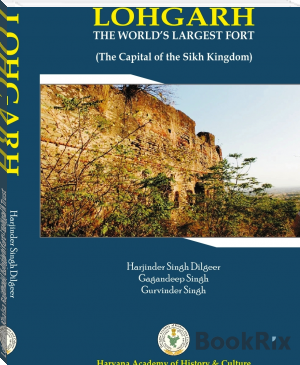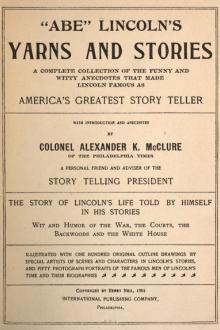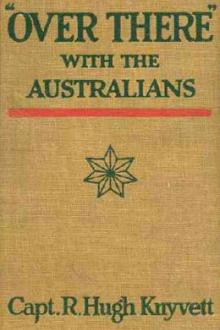Lohgarh - Khalsa Rajdhani, Lohgarh fort - Lohgarh Trust, S. Daljeet Singh Bajwa [early reader books .txt] 📗

- Author: S. Daljeet Singh Bajwa
Book online «Lohgarh - Khalsa Rajdhani, Lohgarh fort - Lohgarh Trust, S. Daljeet Singh Bajwa [early reader books .txt] 📗». Author S. Daljeet Singh Bajwa
Endnotes
1 . Akhbarat-i-Darbar-i-Mu’alla, entry of 15.3.1715
Ahwaal-ul-Khwakeen, 121-24. Elliot & Dowson, cit., Vol II, p 457. Akhbarat-i-Darbar-i-Mu’alla, entry of 3.1715 Akhbarat-i-Darbar-i-Mu’alla, entry of 4.1715 Akhbarat-i-Darbar-i-Mu’alla, entry of 4.1715 Irvine, Later Mughals, Part I, p Akhbarat-i-Darbar-i-Mu’alla, entry of 4.1715 Akhbarat-i-Darbar-i-Mu’alla, entry of 5.1715 Irvine, cit. Vol II, page 314. Mohammed Qasim, Ibratnama, pages 57B to 61A of the manuscript in British Library London, pages 180-84 of the printed They were the employees of Bhai Lakhi Rai As Lakhi Rai Vanjara was dead, and, his sons and grandsons were a part of Banda Singh’s army, the trade activities had come to a halt.
In the Mughal records, his name appears as Daya Dharma and Daya Dhata as It was Hamir Chand His name appears as Hamir Chand Kamboj as well. He ruled Kangra from 1700-1747. Many Mughal records do not spell correct names of the Hindu rulers. Akhbarat-i-Darbar-i-Mu’alla, entry of 7.1715 Perhaps Dheeraj Many Mughal records do not spell names of the Hindu rulers. Akhbarat-i-Darbar-i-Mu’alla, entry of 9.1715 Ibratnama, pages 39A to 46B and 52B to The name of the books of both writers, Mirza Mohammed and Mohammed Qasim is Ibratnama. This was the amount that was recovered from them at the time of their This story has been given only by the author of Siyarul Kesar Singh Chhibber, Bansavalinama Dasan Patsahian Da, p Akhbarat-i-Darbar-i-Mu’alla, entry of 12.1715 Mohammed Qasim, cit, pp 86-87, Kamwar, op.cit., p. 460. Akhbarat-i-Darbar-i-Mu’alla, entry of 2.1716 Irvine, The Later Mughals, II, page 316. R. Wilson, Early Annals of English in Bengal, pp. 96-98, Mirza Mohammed Harsi, Ibratnama, pp 52B to 53A. Ahwal-i-Adina Begh, 20. Later, Farukhsiyar too had met the same type of Ahwaal-ul-Khawakeen, pp. 121-124. Akhbarat-i-Darbar-i-Mu’alla, entry of 3.1716 Khafi Khan, Muntakhab-ul-Lubab, vol II, p 766, Haqiqat-i-Bina-O-Aruz-i- Sikhan, p R. Wilson, Early Annals of English in Bengal, pp. 96-98, Mirza Mohammed Harsi, Ibratnama, pp 52B to 53A. Tarikh-i-Mohammed Shahi. Earlier their number was seventeen; two more had been arrested in between and they too were included in this Akhbarat-i-Darbar-i-Mu’alla, entry of 6.1716 Kamwar mentions that there were 17 companions with Banda Singh but a few days later two more Sikhs were also arrested, and, at the time of execution their number was It means that some more Sikhs had been arrested and added to this group.
Ganesh Das Vadhera, Risala Sahib Numa, p Ajay Singh was born to Sushil Kaur of Banda Singh had married her in the last days of 1710 and even if he was conceived in the first day of marriage, he must have been born after September 1711; hence he was less than five years old at the time of his martyrdom. Mohammed Qasim Aurangabadi, Ahwaal-Ul-Khaakeen, pp 121-124. Khafi Khan, cit., chapter 2, pp 766-67. Amar Singh Kamboj was the son of Raghupati Sahai Kamboj (a dedicated Sikh of the time of Guru Tegh Bahadur), and was a landlord of He and his brother were a part of the army of Guru Gobind Singh. He had participated almost in all the battles of Banda Singh Bahadur. When Banda Singh was arrested from Gurdas Nangal, he had gone to his village. Sahib Kaur presented this turban to Amar Singh, who kept it as a siropao (robe of honour), and he preserved it as Later, his companions began claiming that due to this turban Amar Singh was the chief of the Sikh Panth. Due to this, the companions of Amar Singh began tying turbans of red colour. Lala Ganda Mall Wadhawan, Twareekh-i-Sohdra, as quoted by Giani Garja Singh in Shaheed Bilas. Karam Singh Historian (in his book Banda Singh Bahadur), commenting upon Giani Gian Singh says, “It is bad luck of the Sikhs that their history writers were like those of Giani Gian ” In another article “Ablawan tay Sikh “Karam Singh Historian comments that “Giani Gian Singh was fond of gossip-mongering.” Sewa Singh, Shaheed Bilas, written in Khafi Khan, Muntkhab-ul-Lubab, pp 765-67. Haqiqat Bina-va-Aruz-i-Singhan, published in India Historica Quarterly, March
Chapter 15
Demolition of Lohgarh
Who demolished Lohgarh and How Much Time Did it Take?
The Mughal Emperor and the generals of the Mughal army were scared of Banda Singh Bahadur, Sadhaura and Lohgarh Forts. But, Lohgarh Fort was their bigger concern. The Vanjara Sikhs continued their struggle even after the martyrdom of Baba Banda Singh Bahadur, but were soon captured as they became leaderless. They had started demolition of the Sadhura Fort in 1716. But, Lohgarh Fort was their bigger concern. They were always afraid that if they re-occupied this Fort then again thousands of Mughal soldiers would have to be engaged to combat the Sikh army for many years, and, it would mean loss of lives of thousands of Mughal soldiers, and a lot of money as well; and, still the Mughals would never be able to keep it under their control for a long time. The Sikhs would come again and occupy it. So, following the advice of the army generals, the Mughal Emperor ordered that this port should be totally demolished.
Chowdhry Musa-Ul-Khan1 (known more as Massa Ranghar) of Mandhiala village (13 kilometres from both Amritsar and Jhabal Kalan) was assigned this job. When Banda Singh Bahadur and all the senior generals of the Sikh army had been arrested (in December 1715) and executed (on 9 June 1716), the demolition of the Fort was begun. For this purpose, hundreds of Mughal soldiers and thousands of laborers were engaged. They took up each one hill as a unit, and began demolishing the walls, trenches, foundations and passages of each hill one by one. Ranghars, who had been brought to demolish the Fort and carry massacre of the Sikhs, where, later, got settled in 85 villages in old district of Ambala.
At that time, the families of those persons, who were employees of Bhai Lakhi Rai Vanjara’s tanda (trade caravan), and the families of Sikligars (who used to manufacture weapons and ammunition for the Gurus and Banda Singh) had been living in these hills and in the villages in the foothills of the Fort. This Fort had been built by these Vanjaras and the Sikligars and their forefathers.
It seems that the Mughals would not have only demolished the Fort, but they would have even occupied these villages, one by one. They might have either killed or expelled the Vanjaras and the Sikligars and their families; and, some might have fled from their houses to save themselves from the atrocities of the Mughal soldiers. Those soldiers and the labor, which had been brought here, to demolish the Fort, might have been given possession of the land and the houses belonging to the Vanjaras and the Sikligars. Before 1716, not a single Muslim used to live here. All this land belonged to Lakhi Rai Vanjara and all his employees (Vanjaras) were Sikhs.
It is believes that the demolition of the Fort would have atleast twenty years. A Fort, which was built in 70 to 80 years, at least half time was needed to totally demolish it. It seems that Massa Ranghar personally supervised the demolition of the Fort that is why he had built his palace here. The palace, in which Massa Rangarh lived, the ruins of which can still be seen in Machhrauli village till today. Similarly, there is a village Mughalvali, where workers, who were engaged in the task of demolition, might have been living there; hence, this place might have come to be known as Mughalvali. Even now, all those Muslim families which live in this area are the descendants of those who had come here between 1716 and 1740.
Between Sadhaura and Lohgarh and in the foothills of the Fort, there were more than 50 villages where Vanjaras used to live. The land of these villages was the property of Lakhi Rai Vanjara; and it was inhabited by his employees. The Mughals had killed most of them and their lands given to those workers engaged in demolish of the Fort. In spite of this, some Vanjaras still remained there in these villages. It is possible that these Vanjaras might have co-operated with the Mughals or surrendered to them. This too is possible that some Vanjaras returned
Demolition of Lohgarh u 219
to this place after 1740, when the Fort had been almost demolished and Massa Ranghar had left this area for his native village in Amritsar district. Even nowadays, several Vanjaras and Sikligars are living in this area. They are Sikhs and they perform all their rituals as per Sikh traditions. Some of the villages in this area, and in nearby districts, are even known as Vanjaras villages. These include Ishargarh, Ismailabad, Lohara, Bir Saunti, Haripur Majri, Khaira, Simalvar, Nakhrojpur, Bhukri, Falshanda, Ladva, Raurhki, Mand Kheri, Dilli-Ka- Majra, Deviaspura, Navarsi (Kurukashetra); Bigarh (Fatehbad); Balsola, Nanakpura, Navan Nagar (Pinjaur-Nalagarh road), Sherpur, Bakkarvala, Kalesar, Sunder Bahadurpur, Naushehra, Bilaspur, Buria, Kunjal, Baruda (Yamuna Nagar); Mithapur, Sagrani, Khanpur, Ganauli (Ambala), Raipur Rani, Shahpur, Raurki, Chauki, Nada, Fatehpur, Raili,Kundi, Surajpur, Rajipur, Pinjaur, Prempura, Kiratpur, Maulavali, Karanpur, Karauli, Karaul Fateh Singh, Karul Maula (Panchkula) etc. Some villages in Karnal district too belong to Vanjaras, e.g. Sangoi, Bhara Gaon, Kavahi, Mehtamati, Neval, Tikri, Sugri, Chhapra, Daliyanpur etc. Besides these districts, several Vanjaras live in Charkhi Dadri, Bhiwani, Rohtak, Gurgaon, Kosali, Behri, Gohana, Mahendragarh, Narnaul, Sonepat, Panipat and Gharaunda too. In Himanchal Pradesh too there are several villages where Vanjaras are still living, e.g. Kearda, Patlion, Kishanpur, Thapal (in the old state of Nahan/Sirmaur, in Lohgarh zone), where Guru Har Rai Sahib spent about 13 years), Singpura, Bhatvali, Bannewali, Molokvali, Barotivala, Haripur, Fatehbad, Vikas Nagar, Salakhoi, Vikram Bagh etc. In Punjab too the Vanjaras inhabit in several villages, e.g. Tandi, Navan Gaon (Kharar tehsil); Masoli, Arauli, Dasovala, Lubangarh, Udiavala, Tanda (Machhiwara tehsil); Madwara (Ropar tehsil); Behat (Lidhiana). In Uttar Pradesh and Uttrakhand too Tanda villages are predominately inhabiated by Vanjaras community. All of them are Sikhs and perform their family ceremonies (birth, marriage and death rituals) according to Sikh religion.
Endnotes
Later, on 11 August 1740, he was killed by Sukha Singh and Mah tab Singh.
Chapter 16
Situation After the Destruction
of Lohgarh Fort
It has been said that Lakhi Rai Vanjara had a mansab of four thousand granted by Mughal Emperor Shah Jahan (Athar Ali wrote a book ‘Mughal Nobility Under Aurangzeb’ which gives the names of more than one thousand mansabdars out of which dozens are Hindu Rajput, Maratha and other mansabdars as well but, it does not contain even a single name which belonged to the Sikh community). However, there is no doubt that Lakhi Rai Vanjara was a very rich person; perhaps he was the richest trader of his times. He used to trade from Balkh, Bukhara, Yarkand, Samarkand (in the Central Asia) to Sri Lanka. He had at least three hundred thousand camels, elephants, horses, oxen, buffeloes and mules. To maintain such an animal force, he must be having thousands, may be lakhs of employees, which were known as Vanjaras (employees of Vanjara).
After the execution of the Sikh soldiers, including all the sons, grandsons and great-grandsons of Lakhi Rai Vanjara, and the fall of Lohgarh Fort, thousands of persons associated with his trade caravans had become unemployed. Now, they began wandering from place to place in search of work.
Similarly, some of these, who used to manufacture weapons for Lakhi Rai Vanjara, Guru Sahibs, Banda Singh, too had become jobless. The Mughals too did not give them jobs.
Those workers, who had been associated with trade, some of them got engaged in trade activities, i.e. they got engaged in door-to-door, village to village trade activities. They had experience of trade activities. They knew what good was needed at which place. As they did not have
Situation After the Demolition of Lohgarh Fort u 221
much capital, they could not begin large scale businesses. So, with petty capital, they began to sell some less expensive goods. They would





Comments (0)